The short compositions that make up the Mikrokosmos cycle by Béla Bartók have long provided an indispensable repertory to most teachers of contemporary keyboard technique. In addition, many of these pieces are models of structural transparency that reveal a great deal about the composer's mature compositional technique. Such features recommend these works to the teacher of musical analysis as forcefully as their pianistic features recommend them to the keyboard teacher.
"Boating," from Volume 5 of Mikrokosmos, is such a work. The title of this paper refers to structural unities, plural, because it is concerned with three separate, autonomous musical systems in "Boating" and the interconnection and complementation that exist among them: phrase structure and grouping, pitch-class set structure, and pitch function.
Phrasing and grouping structures in "Boating" are determined by conditions that are similar to those that exist in tonal music. In particular, phrase beginnings are articulated by prominent parallelism or contrast of material, and cadences are articulated by rhythmic caesurae, registral descent, slowing down of activity rate, and so on. Pitch-class sets that are prominently featured in this piece are not described here according to those set-theoretic models associated with Forte and related theorists, most commonly in use today. Rather, I propose a model for the derivation of pitch-class sets that is idiosyncratically suited to the specific structural features of this work. The notion of pitch "function" has to do with the relative hierarchical status of some of those sets. I shall attempt to show how qualities of stability and structural function on the one hand, and instability and decorative function on the other, become associated with certain pitch collections. These differences in turn determine important formal features of "Boating," both in the small and in the large.
Let us begin, then, by asking how the piece breathes: Where do phrases begin and end? Where are the principal structural accents? How is momentum into those accents achieved, and how is it liquidated?
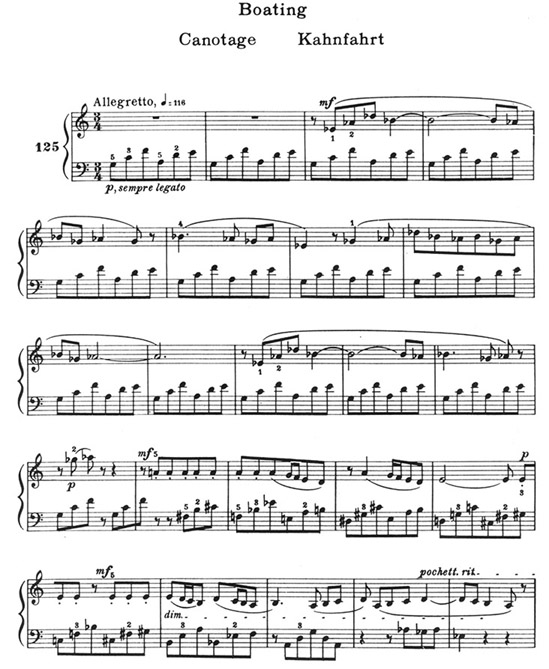
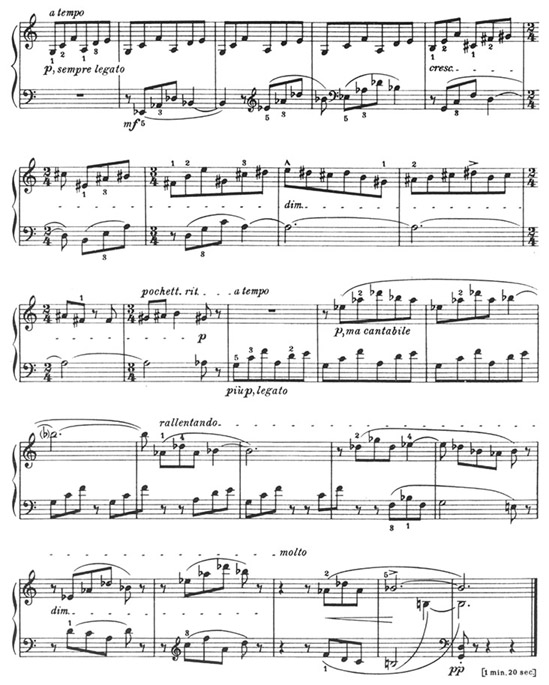
Most prominent among the surface patterns (and typical of the Barcarolle convention to which the title "Boating" points) is the ostinato accompanimental figure that begins the piece. In literal or in varied form, this figure is active throughout most of the movement, and points where the ostinato returns in its original form are moments of striking parallelism that mark many of the phrase beginnings. Note that the ostinato subdivides by contour into two component three-note segments. This subdivision brings about a shadowy suggestion of 6/8 meter, which also points to the Barcarolle convention. The component trichords associated with this segmentation are very important in this piece. We shall refer to these trichords as 'X' and 'Y,' as marked in Example 1.
Example 1.

Like the ostinato figure, the melodic motive in mm. 3-4 occurs, in exact or slightly varied form, at many phrase beginnings. Thus, for example, the first phrase ends at m. 10, and the second phrase begins at m. 11: although the ostinato is uninterrupted, the melody has a rhythmic caesura at mm. 9-10, followed by a new beginning that is exactly parallel to mm. 3-4.
The music in mm. 11-14 is a variant of mm. 3-10. The essential melodic movement is from a rhythmically prolonged  1 to
1 to  1, although the latter is prolonged, through registral transfer in mm. 13-14, rather than agogically as in mm. 9-10. The ostinato figure is momentarily fragmented in m. 14, and there follows sharply contrasting material in mm. 15ff. The
1, although the latter is prolonged, through registral transfer in mm. 13-14, rather than agogically as in mm. 9-10. The ostinato figure is momentarily fragmented in m. 14, and there follows sharply contrasting material in mm. 15ff. The  s in mm. 13-14 thus have a cadential function parallel to the
s in mm. 13-14 thus have a cadential function parallel to the  1 in mm. 9-10, although the strength of the second cadence is severely undermined by the extreme brevity of the second phrase combined with the relatively more tentative way in which the cadence note is prolonged the second time. Indeed, after the comparatively broad and leisurely melody in mm. 3-10, with its three component subphrase groups, the effect of the music in mm. 11-14 is of severe compression, and the abruptly new material of mm. 15ff. seems to release that compression.
1 in mm. 9-10, although the strength of the second cadence is severely undermined by the extreme brevity of the second phrase combined with the relatively more tentative way in which the cadence note is prolonged the second time. Indeed, after the comparatively broad and leisurely melody in mm. 3-10, with its three component subphrase groups, the effect of the music in mm. 11-14 is of severe compression, and the abruptly new material of mm. 15ff. seems to release that compression.
The melody of the third phrase, mm. 15-23, contrasts with the preceding melody from the point of view of texture (staccato instead of legato), rhythm, contour, and pitch. Particularly note that the total pitch content of the melody of mm. 15-23 (the "white-note" diatonic collection) is the complement of the total pitch content of the preceding melody (the "black-note" pentatonic collection).
The ostinato figure, too, is varied. Instead of remaining registrally static, the accompaniment now projects a voice-leading pattern that is sequential. The two-measure sequential groupings are indicated in Ex. 2. That example also indicates the conjunct outer-voice-leading that is implied in the accompaniment here, and which connects the two X trichords in mm. 14 and 21.
Example 2.

Measures 15-23 comprise a beginning-accented phrase. After the emphasis that accrues to the beginning of the phrase due to sudden contrast, that energy is gradually liquidated through registral descent in the melody (it is as if the melodic climax of the phrase is its first note) combined with sequential descent in the accompaniment. The composer emphasizes this sense of decline by diminuendo and rallentando. A cadential effect is brought about by broadening the rate of change in mm. 21-23: the harmonic rhythm of the accompaniment expands when the X collection (transposed) is sustained for a full measure in m. 21; similarly, the b at the downbeat of m. 21 is the cadential pitch of the melody, and there is no further essential melodic unfolding from that point through m. 23.
The left hand motive in mm. 22-23 foreshadows the next phrase by citing a characteristic detail of the "black-note" pentatonic melody. The re-establishment of the opening ostinato in its original register in m. 24, followed by the opening melodic motive, registrally transferred but in every other way intact, signifies the beginning of phrase 4. The business of this phrase is to accumulate energy leading into the strong structural downbeat of m. 31. Several features combine to create a sense of climax at the downbeat of m. 31: it is a registral accent, the highest point of the melodic line in the entire piece; it is a dynamic accent, the goal of a crescendo; it is a metric accent, emphasized by a percussive stress (^); and it begins an agogic accent—for the only time in the piece the ostinato figure gives way to a sustained pedal tone in the accompaniment.
The registral approach to m. 31 is again sequential, this time an ascending sequence that has the effect of accumulating tension (the opposite effect to that of the descending sequence in mm. 15-21). Notice that mm. 27-30 comprise a "real" sequence, and that mm. 27, 28, and 30 are transpositions of one another. Measure 29 presents an interesting detail: it is an elided statement of the sequential motives. Written out as a regular sequence, mm. 27-30 would appear as in Ex. 3(a). Just as, metrically, m. 29 is a momentary compression of the normative 3/4 meter into 2/4, it also contains elisions of parts of the sequential materials in both the accompanimental and the melodic parts. Ex. 3(a) can be taken to represent the underlying, regular form of a sequence of which Bartók's text, reproduced here as Ex. 3(b), represents a kind of surface transformation.
Example 3.
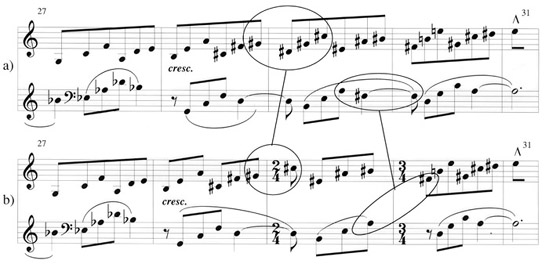
Note that the last pitch of m. 28,  1, has an overlapping function in the "transformed" version, in that it can be understood not just as the last note of the sequential motive in m. 28, but also as the second note of the sequential motive that belongs in measure 29. Similarly, the first note,
1, has an overlapping function in the "transformed" version, in that it can be understood not just as the last note of the sequential motive in m. 28, but also as the second note of the sequential motive that belongs in measure 29. Similarly, the first note,  1, of m. 30 might also represent the last note that belongs in the left-hand sequence in m. 29. The irregularity and compression of the sequential ascent due to the elision in m. 29 contributes to the accumulation of energy into the climax in m. 31. Ex. 3(a) seems overly regular and plain by comparison: the even and balanced sequential groups create repose, and are less suited to the developmental and directional context of the music.
1, of m. 30 might also represent the last note that belongs in the left-hand sequence in m. 29. The irregularity and compression of the sequential ascent due to the elision in m. 29 contributes to the accumulation of energy into the climax in m. 31. Ex. 3(a) seems overly regular and plain by comparison: the even and balanced sequential groups create repose, and are less suited to the developmental and directional context of the music.
Bartók retreats from the climax in m. 31 by registral, diatonic descent in the melody, which recalls the diatonic material in mm. 15-23, reinforced by a diminuendo. Once again, the cadence is emphasized by rhythmic and temporal retardation, followed by a breath, a rest, in m. 34.
The return of the ostinato in its original form in m. 35, combined with a further variant of the opening melody in m. 36, signifies the beginning of the final phrase. The cadential effect of this phrase relative to the piece as a whole, the broad dispersal of musical energy that it accomplishes, is a product of the gradual fragmentation of both the melodic and the accompanimental parts, underscored by molto rallentando and diminuendo.
The last phrase is recapitulatory in that the melodic materials are limited to those of the opening phrases and the accompaniment is derived primarily from the original ostinato. The B-natural of the cadential sonority (a G-major/minor triad) is of special interest: it is the only pitch-class that is excluded from the total pitch content of the opening phrases, which are otherwise chromatically saturated. The B-natural at the end is a cadential inflection, and thus it is comparable to a Picardy third. It is, however, the approach to B-natural that is of the greatest significance. As a cadential pitch, it recalls the melodic cadence in mm. 21-23. If we take the terminal (first and last) notes of the fragments into which the accompaniment is broken up in mm. 39-46, they yield the step-wise voice-leading descent shown in Ex. 4: a1-g1-f1-e1-d1-c1-b.
Example 4.

These notes recall the melody of phrase 3 in its entirety, a reference that emphasizes the parallel cadential function of B-natural in mm. 46-47 as compared to mm. 21-23 and that contributes to the effect of cadential function that the final phrase has relative to the piece as a whole.
Just as the last phrase can be assigned a cadential function relative to the whole, each of the other phrases similarly has an unambiguous formal function. Phrase 1 is expository, setting forth in a leisurely way, as compared to what follows, the principal thematic and harmonic elements of the music. Phrase 2 is transitional, an effect primarily caused by the severe compression of its length. Phrase 3 is also expository, but in the manner of a Classical "second theme": the music here is beginning-accented, has a strong cadence, and is associated with secondary pitch materials. Phrase 4, which treats previous material in a fragmentary, sequential way, leading to a climax, is developmental. These phrase functions, which in their Classical manner of interrelationship contribute a sense of wholeness and unity to the form of the music, are sketched in Ex. 5.
Example 5.

We shall turn now to a more detailed consideration of the pitch collections that are associated with harmonies, motives, and other units of grouping in the piece.
We said already that the ostinato figure divides by contour into two three-note groups which we labeled X and Y. These trichords can easily be reordered to show that they have the same intervallic structure, that they are transpositions of one another: e.g. "G-C-F," "E-A-D." It is in fact the particular intervallic disposition of the opening trichord, a succession of perfect fourths, that is normative and motivic for this piece. See, for example, the figure that begins the melody in m. 3 and is associated with all the subsequent phrase beginnings that parallel this beginning.
In a less obvious way, the perfect-fourth (P4) trichord is an essential motive in the melodic phrase of mm. 15-23 as well. Consider Ex. 6.
Example 6.
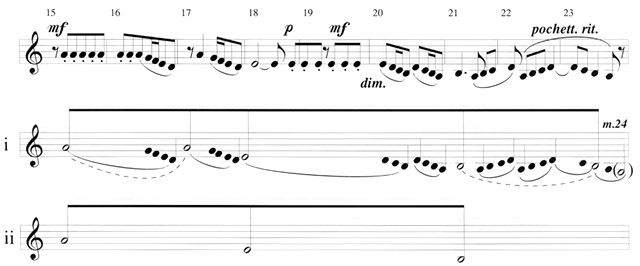
The melody begins with a prolonged a1, sustained for three measures by repetition. A relatively swift stepwise descent leads to e1, which is similarly sustained. Again, a relatively swift stepwise descent at m. 20 reaches its goal, b, at the downbeat of 21. The contour of the melody briefly reverses in mm. 21-23, while it dwells on the group of pitches (a-b-c1-d1) that led into the cadential b. The effect here is of peroration, or cadential prolongation, so that b is sustained as an underlying basic pitch through mm. 21-23. Thus, the skeletal melodic structure in mm. 15-21 is a1-e1-b, the P4 trichord. As sometimes happens in tonal music, this is an instance of a motive occurring not only as a prominent surface collection of contiguous pitches, but also as a conspicuous underlying formation connected by surface material.
When the P4 trichord (transposed) occurs as part of the melodic "head" motive that marks phrase beginnings at mm. 3, 11, 25, and 36, it groups with a fourth element: the complete four-note collection is " -
- -
- -
- ." In each of the instances cited here, these four pitches are grouped rhythmically. This four-note motivic grouping is also used independently: see mm. 25-30, where it is treated sequentially, and mm. 43-44.
." In each of the instances cited here, these four pitches are grouped rhythmically. This four-note motivic grouping is also used independently: see mm. 25-30, where it is treated sequentially, and mm. 43-44.
The next largest pitch collection that has independent life in this piece is what I previously referred to as the "black-note" pentatonic collection, to which the melodic materials associated with phrases 1, 2, and 5 are limited.
The next largest collection is the diatonic hexachord associated with the ostinato figure in its entirety: "C-D-E-F-G-A." The ostinato figure generally projects this hexachord in its original transposition, although it occurs in other transpositions in the sequential treatment in mm. 27-31.
Finally, the largest pitch collection that occurs conspicuously in this piece is the seven-note diatonic collection in mm. 15-23 and 31-34. As unordered pitch-class sets, these two instances of the diatonic collection are, of course, transpositionally equivalent. Given the specific intervallic and registral assignments that the two diatonic collections have in this piece, they are inversionally symmetrical as well (see Ex. 7).
Example 7.

We have seen that the stepwise material in mm. 15-24 fills out (diminutes) the skeletal minor seventh a1-b. The intervallic structure of the diatonic collection that spans this interval—b-c1-d1-e1-f1-g1-a1—is the mirror image of the intervallic structure of the collection in 31-34: e2- 2-
2- 2-b1-
2-b1- 1-
1- 1-
1- 1. Finally, recall that a reprise of this collection is suggested by the left-hand material in mm. 39-46.
1. Finally, recall that a reprise of this collection is suggested by the left-hand material in mm. 39-46.
The above list of 3-, 4-, 5-, 6-, and 7-note collections summarizes all of the pitch collections that are utilized in this piece. Of the greatest interest, however, is that these collections are closely interrelated: They are all segments of the circle of fifths.
Just as the trichord can be arranged as a succession of perfect fourths, so can the tetrachord:  -
- -
- -
- becomes
becomes  -
- -
- -
- . The trichord can be generated as a succession of perfect fourths, and the tetrachord can be similarly generated by adding another perfect fourth. In the same way, the pentachord can be generated by adding another perfect fourth to the tetrachord:
. The trichord can be generated as a succession of perfect fourths, and the tetrachord can be similarly generated by adding another perfect fourth. In the same way, the pentachord can be generated by adding another perfect fourth to the tetrachord:  -
- -
- -
- -
- . Adding another perfect fourth to the pentachord (here transposed to match the actual pitch-class collection that appears in the piece) will yield the diatonic hexachord associated with the ostinato figure: E-A-D-G-C-F. Finally, adding one more P4 will give a collection that can be reordered as the diatonic scale: B-E-A-D-G-C-F.
. Adding another perfect fourth to the pentachord (here transposed to match the actual pitch-class collection that appears in the piece) will yield the diatonic hexachord associated with the ostinato figure: E-A-D-G-C-F. Finally, adding one more P4 will give a collection that can be reordered as the diatonic scale: B-E-A-D-G-C-F.
Ex. 8 shows each of these collections as a segment of the circle of fifths.
Example 8.
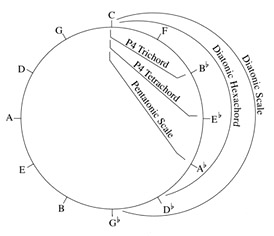
Any three-note segment will correspond to some transposition of the P4 trichord; any four-note segment will correspond to some transposition of the P4 tetrachord; any five-note segment will correspond to the pentatonic scale; any six-note segment is a diatonic hexachord; and any seven-note segment will correspond to the diatonic scale. We have here a new and strong sense in which the P4 is motivic for this piece: the generation of sets by adding successively more perfect fourths is the unifying principle whereby all of the pitch collections in this piece are interrelated.
Finally, let us consider some parallelisms that this piece features between its local and global relationships. We have seen that the smallest of the pitch collections, the component trichords X and Y of the ostinato figure, have the same intervallic structure. From a functional point of view, however, they are dissimilar. Note that the voicings of these trichords are such that each of the elements of Y is related by step to the equivalent element in X. Metrically, Y is in the weaker position. The combined effect of the unaccented position of Y relative to X, and the fact that Y is a stepwise contraction of X, is that Y functions as a neighbor chord to X.
Thus X is the structural chord, Y is the prolonging or decorative chord. We can go further. Because g always appears on a downbeat and at the beginning of each repetition of the ostinato figure, it attracts special attention; it almost has the effect of a pedal tone. Certainly g is the structurally predominant pitch in the ostinato figure, and it has the status of a harmonic tonal center whenever the ostinato is active in its original transposition. Bartók's choice of a G triad in root position to harmonize the cadential  1 at the close seems to affirm the intent of "G centeredness" in this piece.
1 at the close seems to affirm the intent of "G centeredness" in this piece.
The dichotomy that the ostinato sets forth in the small between X as a central chord—specifically a g-centered chord—and Y as a secondary area is reflected in larger-scale shifts of emphasis as well.
This is most dramatically the case in the climax in m. 31. The outer voices at the downbeat of 31 reach the pitches that are the goals of their respective sequential ascents: a-e2. Emphasized climactically in all of the ways described above, these are the same notes, the same interval (in compound form), as the outer voices of the neighboring Y trichord of the ostinato figure.
In a more subtle way, the Y trichord is also a prominent feature of the pitch materials in mm. 15-23, as shown in Ex. 9.
Example 9.
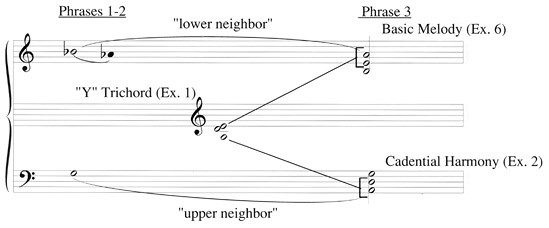
The chief harmony of this phrase is the X trichord in m. 21: A-d-g. The basic structure of the melody is a1-e1-b—see the discussion of Ex. 6, above. Notice that the Y trichord "A-D-E" intersects with both of these: the notes A and D are shared with the harmony in m. 21; A and E are shared with the basic melody structure. Notice too that the registral extremes in phrase 3—the highest melodic and the lowest harmonic notes—are A and a1, and that the two trichords together are symmetrical around an a axis. The pitches at the registral outer limits in phrase 3 thus have a neighboring relation with the principal outer-voice pitches associated with phrase 1: g and  1. In other words, not only is there a strong association between the total pitch content of phrase 3 and the Y trichord in the ostinato, but also the functional relationship between the principal pitches in phrase 3 and the principal pitches in phrase 1 parallels the functional relationship between the Y trichord and the X trichord in the ostinato figure.
1. In other words, not only is there a strong association between the total pitch content of phrase 3 and the Y trichord in the ostinato, but also the functional relationship between the principal pitches in phrase 3 and the principal pitches in phrase 1 parallels the functional relationship between the Y trichord and the X trichord in the ostinato figure.
****
In several places, this analysis indicates structural features that are characteristic of Bartók's style. For example, the chromatic near-saturation of the opening phrase can be understood as an instance of "polymodal chromaticism" ( pentatonic in the right hand, G mixolydian in the left), a stylistic trait that frequently shows up in Bartók's music. Parallelism between local and global structures is a feature of other compositions by Bartók; the best known example is the first movement of the Music for Strings, Percussion, and Celesta. Similarly, Bartók often favored the use of symmetrically related pitch collections.
pentatonic in the right hand, G mixolydian in the left), a stylistic trait that frequently shows up in Bartók's music. Parallelism between local and global structures is a feature of other compositions by Bartók; the best known example is the first movement of the Music for Strings, Percussion, and Celesta. Similarly, Bartók often favored the use of symmetrically related pitch collections.
What makes "Boating" especially interesting, however, is that here these surface stylistic conditions are manifestations of a more general, underlying principle, namely the generation of pitch-class sets by the circle of fifths. These segmentations of pitch correspond to rhythmic segmentations that are brought about by motivic grouping and phrase structure, and these in turn are articulated with great clarity in this piece. Similarly, a parallel functional relationship is projected among parallel pitch collections at the highest and lowest hierarchical levels, and those pitch collections conform to the circle of fifths derivation.
In this work, there is a high degree of conformity among the separate structural domains as well as a severe constraint upon the content of structurally important pitch collections. While these are conditions that make possible an elegant analysis, they are not likely to be found in works of greater span and more extensive formal development. At the same time, the high degree of structural conformity and consistency render "Boating," and works like it, analytically "accessible" and potentially very useful to the teacher of theory and analysis.
Note that the initial questions raised in this paper had to do with segmentation of the musical surface of a kind that is similar to that which exists in tonal music. Moreover, the determination of phrasing and grouping structure provided an explicit basis upon which to determine pitch-class set structure. Issues of phrasing and articulation touch upon the most tangible aspects and our most immediate experience of music. With a little nurturance and coaching, students are capable of responding with great sensitivity to questions of phrasing. This in turn can lead to increased confidence and ability when it comes to making inferences about sophisticated aspects of pitch structure. Allowing for the delays and detours brought about by an interactive teaching style, the way in which the analysis presented here unfolds parallels, albeit in a condensed, concentrated form, the way in which such an analysis might be effectively presented in the classroom.


